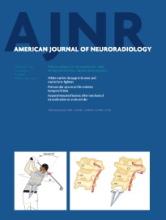Index by author
Lim, Y.-M.
- FELLOWS' JOURNAL CLUBBrainYou have accessUtility of Proton MR Spectroscopy for Differentiating Typical and Atypical Primary Central Nervous System Lymphomas from Tumefactive Demyelinating LesionsS.-S. Lu, S.J. Kim, H.S. Kim, C.G. Choi, Y.-M. Lim, E.J. Kim, D.Y. Kim and S.H. ChoAmerican Journal of Neuroradiology February 2014, 35 (2) 270-277; DOI: https://doi.org/10.3174/ajnr.A3677
The utility of MRS in differentiating lymphoma from tumefactive demyelination was assessed in 44 patients with the former and 21 with the latter. A Cho/Cr over 2.58 and a high lipid/lactate peak were more common in lymphoma, therefore MRS may help in differentiating these 2 entities.
Lin, C.-P.
- BrainOpen AccessAssessment of Angiographic Vascularity of Meningiomas with Dynamic Susceptibility Contrast-Enhanced Perfusion-Weighted Imaging and Diffusion Tensor ImagingC.H. Toh, K.-C. Wei, C.N. Chang, Y.-W. Peng, S.-H. Ng, H.-F. Wong and C.-P. LinAmerican Journal of Neuroradiology February 2014, 35 (2) 263-269; DOI: https://doi.org/10.3174/ajnr.A3651
Linn, J.
- NeurointerventionYou have accessHyperattenuated Intracerebral Lesions after Mechanical Recanalization in Acute StrokeN. Lummel, G. Schulte-Altedorneburg, C. Bernau, T. Pfefferkorn, M. Patzig, H. Janssen, C. Opherk, H. Brückmann and J. LinnAmerican Journal of Neuroradiology February 2014, 35 (2) 345-351; DOI: https://doi.org/10.3174/ajnr.A3656
Liu, S.
- EDITOR'S CHOICEBrainOpen AccessUse of FLAIR Imaging to Identify Onset Time of Cerebral Ischemia in a Canine ModelX.-Q. Xu, Q.-Q. Zu, S.-S. Lu, Q.-G. Cheng, J. Yu, Y. Sheng, H.-B. Shi and S. LiuAmerican Journal of Neuroradiology February 2014, 35 (2) 311-316; DOI: https://doi.org/10.3174/ajnr.A3689
After an infarction-inducing procedure, 20 dogs were imaged at 3, 4, 5, 6, and 24 hours with FLAIR and DWI. A mismatch between the 2 sequences (positive DWI and negative FLAIR) was found to reliably predict the time of infarct onset. By 6 hours, 95% of dogs had FLAIR abnormalities and by 24 hours all did. However, at 3 hours only 15% of dogs showed positive FLAIR studies. These results could serve as guidelines to estimate the time of onset of ischemic events.
Lober, R.M.
- FELLOWS' JOURNAL CLUBPediatric NeuroimagingYou have accessArterial Spin-Labeled Perfusion of Pediatric Brain TumorsK.W. Yeom, L.A. Mitchell, R.M. Lober, P.D. Barnes, H. Vogel, P.G. Fisher and M.S. EdwardsAmerican Journal of Neuroradiology February 2014, 35 (2) 395-401; DOI: https://doi.org/10.3174/ajnr.A3670
ASL was used to evaluate 54 children with recently diagnosed brain tumors using a pseudocontinuous technique and blood flow was calculated for all masses. Blood flow was higher in grade 3 and 4 tumors than in lower grade ones. Although ASL was unable to separate tumors by histology, perfusion was found to be higher in medulloblastomas than in pylocytic astrocytomas.
Lowe, M.J.
- EDITOR'S CHOICEBrainYou have accessDiffusion Measures Indicate Fight Exposure–Related Damage to Cerebral White Matter in Boxers and Mixed Martial Arts FightersW. Shin, S.Y. Mahmoud, K. Sakaie, S.J. Banks, M.J. Lowe, M. Phillips, M.T. Modic and C. BernickAmerican Journal of Neuroradiology February 2014, 35 (2) 285-290; DOI: https://doi.org/10.3174/ajnr.A3676
Boxers and mixed martial arts athletes underwent brain DTI and the results were correlated with number of fights, knockouts, age, weight, and years of education. Total knockouts in boxers increased diffusivity in the corpus callosum, cingulate, pericalcarine, precuneus, and amygdala, while in martial arts athletes only the posterior cingulate was abnormal. Thus, fight exposure but not the number of fights can be used to predict microstructural brain damage.
Lu, S.-S.
- EDITOR'S CHOICEBrainOpen AccessUse of FLAIR Imaging to Identify Onset Time of Cerebral Ischemia in a Canine ModelX.-Q. Xu, Q.-Q. Zu, S.-S. Lu, Q.-G. Cheng, J. Yu, Y. Sheng, H.-B. Shi and S. LiuAmerican Journal of Neuroradiology February 2014, 35 (2) 311-316; DOI: https://doi.org/10.3174/ajnr.A3689
After an infarction-inducing procedure, 20 dogs were imaged at 3, 4, 5, 6, and 24 hours with FLAIR and DWI. A mismatch between the 2 sequences (positive DWI and negative FLAIR) was found to reliably predict the time of infarct onset. By 6 hours, 95% of dogs had FLAIR abnormalities and by 24 hours all did. However, at 3 hours only 15% of dogs showed positive FLAIR studies. These results could serve as guidelines to estimate the time of onset of ischemic events.
- FELLOWS' JOURNAL CLUBBrainYou have accessUtility of Proton MR Spectroscopy for Differentiating Typical and Atypical Primary Central Nervous System Lymphomas from Tumefactive Demyelinating LesionsS.-S. Lu, S.J. Kim, H.S. Kim, C.G. Choi, Y.-M. Lim, E.J. Kim, D.Y. Kim and S.H. ChoAmerican Journal of Neuroradiology February 2014, 35 (2) 270-277; DOI: https://doi.org/10.3174/ajnr.A3677
The utility of MRS in differentiating lymphoma from tumefactive demyelination was assessed in 44 patients with the former and 21 with the latter. A Cho/Cr over 2.58 and a high lipid/lactate peak were more common in lymphoma, therefore MRS may help in differentiating these 2 entities.
Lummel, N.
- NeurointerventionYou have accessHyperattenuated Intracerebral Lesions after Mechanical Recanalization in Acute StrokeN. Lummel, G. Schulte-Altedorneburg, C. Bernau, T. Pfefferkorn, M. Patzig, H. Janssen, C. Opherk, H. Brückmann and J. LinnAmerican Journal of Neuroradiology February 2014, 35 (2) 345-351; DOI: https://doi.org/10.3174/ajnr.A3656
Mader, I.
- BrainOpen AccessLocal and Global Fiber Tractography in Patients with EpilepsyC. Anastasopoulos, M. Reisert, V.G. Kiselev, T. Nguyen-Thanh, A. Schulze-Bonhage, J. Zentner and I. MaderAmerican Journal of Neuroradiology February 2014, 35 (2) 291-296; DOI: https://doi.org/10.3174/ajnr.A3752
Maeder, P.
- BrainOpen AccessPerfusion Measurement in Brain Gliomas with Intravoxel Incoherent Motion MRIC. Federau, R. Meuli, K. O'Brien, P. Maeder and P. HagmannAmerican Journal of Neuroradiology February 2014, 35 (2) 256-262; DOI: https://doi.org/10.3174/ajnr.A3686








